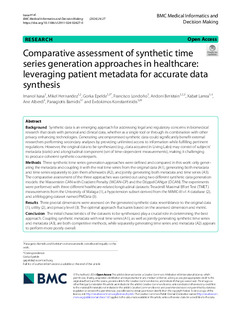| dc.rights.license | Attribution 4.0 International | |
| dc.contributor.author | Isasa Reinoso, Imanol | |
| dc.contributor.author | Alberdi Aramendi, Ane | |
| dc.contributor.other | Hernandez, Mikel | |
| dc.contributor.other | Epelde, Gorka | |
| dc.contributor.other | Londoño, Francisco | |
| dc.contributor.other | Beristain, Andoni | |
| dc.contributor.other | Larrea Lizartza, Xabat | |
| dc.contributor.other | Bamidis, Panagiotis | |
| dc.contributor.other | Konstantinidis, Evdokimos | |
| dc.date.accessioned | 2024-02-02T08:53:03Z | |
| dc.date.available | 2024-02-02T08:53:03Z | |
| dc.date.issued | 2024 | |
| dc.identifier.issn | 1472-6947 | |
| dc.identifier.other | https://katalogoa.mondragon.edu/janium-bin/janium_login_opac.pl?find&ficha_no=175904 | |
| dc.identifier.uri | https://hdl.handle.net/20.500.11984/6198 | |
| dc.description.abstract | Background
Synthetic data is an emerging approach for addressing legal and regulatory concerns in biomedical research that deals with personal and clinical data, whether as a single tool or through its combination with other privacy enhancing technologies. Generating uncompromised synthetic data could significantly benefit external researchers performing secondary analyses by providing unlimited access to information while fulfilling pertinent regulations. However, the original data to be synthesized (e.g., data acquired in Living Labs) may consist of subjects’ metadata (static) and a longitudinal component (set of time-dependent measurements), making it challenging to produce coherent synthetic counterparts.
Methods
Three synthetic time series generation approaches were defined and compared in this work: only generating the metadata and coupling it with the real time series from the original data (A1), generating both metadata and time series separately to join them afterwards (A2), and jointly generating both metadata and time series (A3). The comparative assessment of the three approaches was carried out using two different synthetic data generation models: the Wasserstein GAN with Gradient Penalty (WGAN-GP) and the DöppelGANger (DGAN). The experiments were performed with three different healthcare-related longitudinal datasets: Treadmill Maximal Effort Test (TMET) measurements from the University of Malaga (1), a hypotension subset derived from the MIMIC-III v1.4 database (2), and a lifelogging dataset named PMData (3).
Results
Three pivotal dimensions were assessed on the generated synthetic data: resemblance to the original data (1), utility (2), and privacy level (3). The optimal approach fluctuates based on the assessed dimension and metric.
Conclusion
The initial characteristics of the datasets to be synthesized play a crucial role in determining the best approach. Coupling synthetic metadata with real time series (A1), as well as jointly generating synthetic time series and metadata (A3), are both competitive methods, while separately generating time series and metadata (A2) appears to perform more poorly overall. | en |
| dc.language.iso | eng | |
| dc.publisher | Springer Nature | |
| dc.rights | © 2024 The Authors | |
| dc.rights.uri | http://creativecommons.org/licenses/by/4.0/ | |
| dc.subject | Time series | en |
| dc.subject | Synthetic data | en |
| dc.subject | Privacy-preserving data sharing | en |
| dc.subject | Health data | en |
| dc.title | Comparative assessment of synthetic time series generation approaches in healthcare: leveraging patient metadata for accurate data synthesis | |
| dcterms.accessRights | http://purl.org/coar/access_right/c_abf2 | |
| dcterms.source | BMC Medical Informatics and Decision Making | |
| local.contributor.group | Análisis de datos y ciberseguridad | |
| local.description.peerreviewed | true | |
| local.identifier.doi | https://doi.org/10.1186/s12911-024-02427-0 | |
| local.contributor.otherinstitution | https://ror.org/0023sah13 | |
| local.contributor.otherinstitution | https://ror.org/000xsnr85 | |
| local.contributor.otherinstitution | https://ror.org/01a2wsa50 | |
| local.contributor.otherinstitution | https://ror.org/02j61yw88 | |
| local.contributor.otherinstitution | https://ror.org/05vpgt980 | |
| local.source.details | Vol. 24. N. 1. N. art. 27, 2024 | |
| oaire.format.mimetype | application/pdf | |
| oaire.file | $DSPACE\assetstore | |
| oaire.resourceType | http://purl.org/coar/resource_type/c_6501 | |
| oaire.version | http://purl.org/coar/version/c_970fb48d4fbd8a85 | |
| oaire.funderName | Comisión Europea | |
| oaire.funderIdentifier | https://ror.org/00pz2fp31 http://data.crossref.org/fundingdata/funder/10.13039/501100003086 | |
| oaire.fundingStream | H2020 | |
| oaire.awardNumber | 101007990 | |
| oaire.awardTitle | VIrtual healTh And weLlbeing Living Lab InftraStructurE (VITALISE) | |
| oaire.awardURI | Sin información | |








